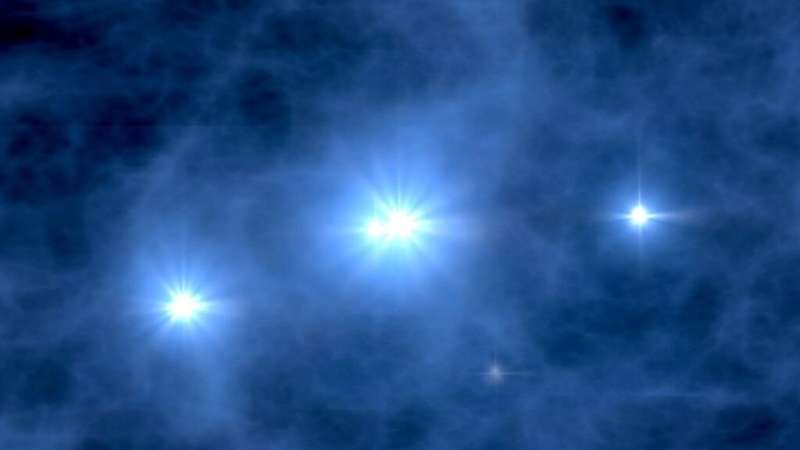This article has been reviewed according to Science X's editorial process and policies. Editors have highlighted the following attributes while ensuring the content's credibility:
fact-checked
peer-reviewed publication
trusted source
proofread
James Webb Telescope is getting closer to finding what ionized the universe

Astronomers have determined that so-called "leaky" galaxies may have responsible for triggering the last great transformational epoch in our universe, one which ionized the neutral interstellar gas.
Billions of years ago our universe was a lot smaller and a lot hotter than it is today. At very early times it was so small and hot that it was in the state of a plasma, where electrons were separated from atomic nuclei. But when the universe was roughly 380,000 years old, it cooled to the point that electrons could recombine onto their nuclei, forming a soup of neutral atoms.
However, observations of the present-day universe reveal that almost all the matter in the universe is not neutral at all. Instead it's ionized, once again in the state of a plasma. Something had to happen in the intervening billions of years to transform the neutral gas of the cosmos into an ionized plasma. Astronomers call this event the Epoch of Reionization and suspect that it happened within the first few hundred million years after the Big Bang. But they are not sure how this transformational event proceeded.
One of the great debates in modern cosmology is the source of reionization. One hypothesis is that quasars are responsible. Quasars are the ultra bright cores surrounding supermassive black holes which pump out enormous amounts of high energy radiation. This radiation could easily flood the universe and transform it from neutral to ionized. But the problem with this hypothesis is that quasars are relatively rare, and so they have difficulty covering the volume of the universe.
Another hypothesis is that young galaxies rich with star formation are responsible. In this scenario the process of ionizing the neutral gas is more spread out throughout the universe. Each individual galaxy is only capable of ionizing the gas in its nearby vicinity, but since there are so many galaxies it's possible to reionization the entire universe. But the only way to do this is if enough high energy radiation leaks out of galaxies and into the surrounding medium.
One team of astronomers have used the James Webb Space Telescope to investigate this hypothesis. They can't study the radiation coming out of the galaxies directly, because that radiation gets absorbed by the billions of light-years worth of matter between us and those galaxies. So instead they had to look for other clues. Using the James Webb's ability to study distant galaxies, they were able to measure how compact the galaxies were, and how rich in star formation they were. They were then able to compare these galaxies to similar galaxies found i- the present day universe to create an estimate of the amount of radiation leaking from them.
They estimate that on average the galaxies in the early universe leaked roughly 12% of their available high energy photons. This is just enough to potentially reionization the entire cosmos in a relatively short amount of time. The findings are published in the journal Astronomy & Astrophysics.
The results are not conclusive, however, because of the number of assumptions that the astronomers had to make. But it does point in an intriguing direction in solving this long-standing cosmic riddle.
More information: S. Mascia et al, Closing in on the sources of cosmic reionization: first results from the GLASS-JWST program, Astronomy & Astrophysics (2023). DOI: 10.1051/0004-6361/202345866
Journal information: Astronomy & Astrophysics
Provided by Universe Today





















